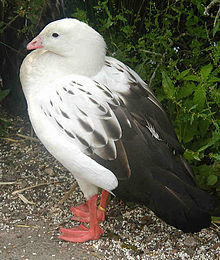Andean goose
This article includes a list of general references, but it remains largely unverified because it lacks sufficient corresponding inline citations. (November 2013) |
| Andean goose | |
|---|---|

| |
| Scientific classification | |
| Kingdom: | Animalia |
| Phylum: | Chordata |
| Class: | Aves |
| Order: | Anseriformes |
| Family: | Anatidae |
| Genus: | Chloephaga |
| Species: | C. melanoptera
|
| Binomial name | |
| Chloephaga melanoptera (Eyton, 1838)
| |

| |
| Synonyms | |
|
Oressochen melanopterus | |
The Andean goose (Chloephaga melanoptera) is a member of the duck, goose and swan family Anatidae. It is also known as the wallata. It is in the shelduck subfamily Tadorninae.
It is resident around lakes and marshes in the high Andes, usually well above 3,000 m (9,800 ft). It is largely terrestrial and avoids swimming except in emergencies.
This heavily built bird has a tiny pink bill and white plumage except for black in the wings and tail. The female is similar to the male except that it is smaller.
The Andean goose is a grazing species, eating grasses. It nests on the ground in a bare scrape near water, laying 6–10 eggs. It is territorial in the breeding season, but otherwise forms small flocks.
Based on a molecular phylogenetic study published in 2014, some authorities place this species together with the Orinoco goose in the resurrected genus Oressochen.[2][3][4]

Physiology and hemoglobin adaptation[]
Andean geese have developed a mutation in their hemoglobin that has led to a vast increase in hemoglobin-oxygen affinity. More specifically, Hiebl et al. found that the Andean goose has developed mutations that lead to five amino-acid substitutions in the alpha-chain and five substitutions in the beta-chain of their hemoglobin.[5] A particular substitution in the Andean goose beta-chain has led to the elimination of a Van der Waals interaction between the alpha-chain and the beta-chain.[6] This has destabilized the T-state (the deoxygenated state of hemoglobin), which has led to a higher affinity for being in the R-state (oxygenated state of hemoglobin).[6] Overall, this mutation increases the hemoglobin-oxygen affinity of the Andean goose.
References[]
- ^ BirdLife International (2016). "Chloephaga melanoptera". IUCN Red List of Threatened Species. 2016: e.T22679972A92836647. doi:10.2305/IUCN.UK.2016-3.RLTS.T22679972A92836647.en. Retrieved 12 November 2021.
- ^ Bulgarella, M.; Kopuchian, C.; Giacomo, A.S.D.; Matus, R.; Blank, O.; Wilson, R.E.; McCracken, K.G. (2014). "Molecular phylogeny of the South American sheldgeese with implications for conservation of Falkland Islands (Malvinas) and continental populations of the Ruddy-headed Goose Chloephaga rubidiceps and Upland Goose C. picta". Bird Conservation International. 24 (1): 59–71. doi:10.1017/S0959270913000178.
- ^ Jaramillo, Alvaro (July 2014). "Proposal 637: Treat Chloephaga melanoptera and Neochen jubata as congeners". South American Classification Committee, American Ornithologists' Union. Retrieved 12 June 2021.
- ^ Davenport, L.; Endo, W.; Kriese, K. (2020). Schulenberg, T.S. (ed.). "Orinoco Goose (Oressochen jubatus), version 1.0". Birds of the World. Ithaca, NY, USA: Cornell Lab of Ornithology. Retrieved 12 June 2021.
- ^ Hiebl, I; Braunitzer, G & Schneeganss, D (1987). "The primary structures of the major and minor hemoglobin-components of adult Andean goose (Chloephaga melanoptera, Anatidae): the mutation Leu----Ser in position 55 of the beta-chains". Biological Chemistry Hoppe-Seyler. 368 (12): 1559–1569. doi:10.1515/bchm3.1987.368.2.1559. PMID 3442599.
- ^ a b Storz, Jay; Hideaki Moriyama (June 2008). "Mechanisms of Hemoglobin Adaptation to High Altitude Hypoxia". High Altitude Medicine and Biology. 9 (2): 148–157. doi:10.1089/ham.2007.1079. PMC 3140315. PMID 18578646.
| Wikimedia Commons has media related to Chloephaga melanoptera. |
| Wikispecies has information related to Chloephaga melanoptera. |
- IUCN Red List least concern species
- Geese
- Chloephaga
- Birds of the Andes
- Birds described in 1838
- Taxa named by Thomas Campbell Eyton

